Every year, domestic cats kill 1.3 to 4 billion wild birds. This high number shows how many birds face danger from predators. Besides cats, various birds like hawks and crows also hunt other birds, showing us a different side of nature’s food chain.
Let’s explore the hunting lifestyles of birds of prey. We’ll look at things like how Harris’s Hawks catch their prey and how majestic eagles are great at finding food. This piece will dive into the world of bird predators. It will show how raptors are key in the ecosystem and give a chance to learn about these amazing birds.
Key Takeaways
- Domestic cats are a significant threat to wild bird populations, killing between 1.3 and 4 billion birds annually.
- A diverse range of birds, including raptors, corvids, and woodpeckers, engage in the behavior of preying on other birds.
- Raptors, such as hawks and eagles, play a crucial role in the ecosystem by preying on smaller bird species.
- Understanding the complex predator-prey relationships among birds is essential for conservation efforts and appreciating the natural world.
- Observing birds of prey in the wild or at educational programs can provide a unique and captivating experience for nature enthusiasts.
Introduction to Birds of Prey
The world of birds of prey, or raptors, is thrilling to learn about. Predatory birds use sharp beaks and strong talons. They have amazing eyesight and hearing for efficient hunting.
Definition and Characteristics of Raptors
Raptors are diverse birds including eagles and owls. They have hooked beaks and strong feet for hunting. Each raptor, from Bald Eagles to Screech Owls, has unique skills for finding and catching prey.
Diversity of Raptors and Their Habitats
There are over 560 raptor species worldwide, found in every continent except Antarctica. They live in fields, forests, and urban areas. Raptors like the Peregrine Falcon and Barn Owl show their special skills in their own environments.
| Raptor Species | Habitat |
|---|---|
| Red-tailed Hawk | Open fields and grasslands |
| Peregrine Falcon | Cliffs, urban areas |
| Great Horned Owl | Forests, woodlands |
| Bald Eagle | Coastal areas, near large bodies of water |
The Remarkable Harris’s Hawks
Harris’s Hawks are extraordinary birds of prey with unique group hunting skills. They are found in the southwestern United States, Mexico, and beyond. They are a favorite among birdwatchers and scientists for their teamwork and social lives.
Cooperative Hunting Tactics
These hawks impress with their teamwork in hunting. They use several clever tactics to catch their prey together. For example, they combine a ‘surprise pounce’ and ‘flush and ambush’ methods, and even a ‘relay attack’ when chasing prey.
The way they work together and communicate during hunts is outstanding. They use sounds, movements, and wing positions to coordinate. This shows how intelligent and social they are compared to other birds of prey.
Group Nesting and Social Dynamics
Beyond hunting, Harris’s Hawks also build and raise their young in groups. This setup includes two males and a female, boosting their young ones’ protection and care. It’s a smart way to ensure nesting success.
They also do something called ‘back-standing.’ This is where they stand on each other’s backs. It’s not just for seeing better; it helps them bond and shows their tight-knit community life.
The Harris’s Hawks dazzle with their teamwork in hunting and their complex social life. They are a prime example of how amazing and varied raptors can be.
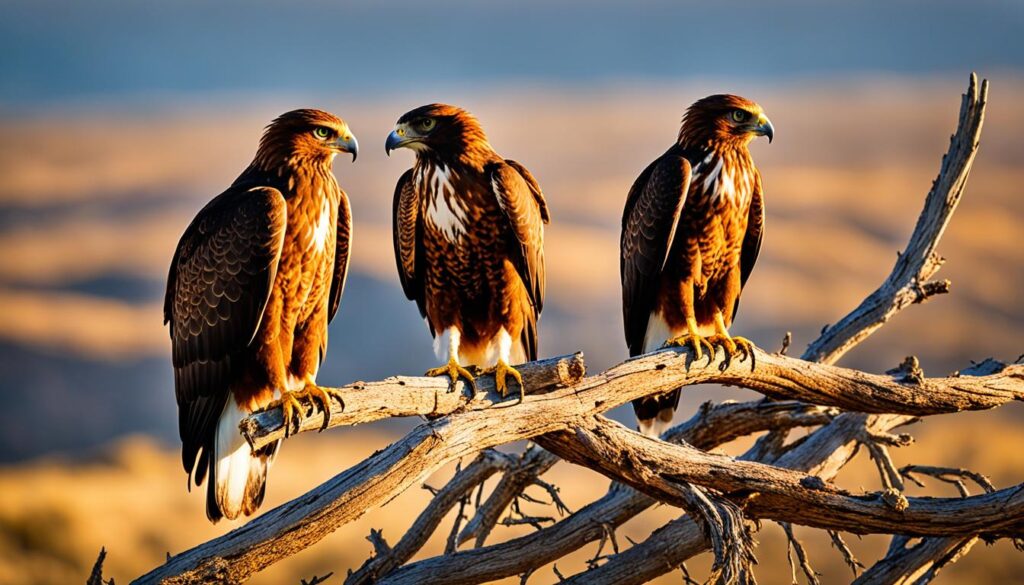
Predatory Behaviors of Common Birds of Prey
Red-Tailed Hawks: Hunters of Open Fields
The Red-Tailed Hawk is a standout among North America’s birds of prey. It excels in hunting in open fields. These birds display special bird of prey hunting behaviors to find, chase, and catch their food efficiently.
Atop trees, utility poles, or buildings, Red-Tailed Hawks have a great view of the land below. With sharp eyesight, they look for small animals like rodents or reptiles. They also watch for other birds to swoop down on. When they spot a meal, they dive down quickly and use their sharp talons to catch it.
The raptor predation methods of Red-Tailed Hawks show their skill and adaptability. Their strong wings and excellent vision let them soar high and see clearly. They time their attacks just right, thanks to their acute hunting instincts. This makes them very successful hunters.
In open fields, Red-Tailed Hawks like to sit up high and look around. They watch for movement and life signs. Their ability to be patient and strike exactly when they need to contribute greatly to their hunting success. They combine their physical strength with sharp hunting senses perfectly.
The hunting style of the Red-Tailed Hawk shows off its clever strategies and uses of nature. These birds of prey have figured out how to do very well in their environments. Learning about their hunting helps us see how the natural world works, with its avian predator-prey interactions.
what birds eat other birds
In nature, some birds eat other birds. This is called avian cannibalism. It’s a key part of the bird world. Birds like raptors and corvids often hunt other birds, including their young and their eggs.
Harris’s Hawks are a great example. They work together to catch birds bigger than themselves. Red-tailed Hawks, on the other hand, prefer smaller birds for their meals.
- A Great Blue Heron once ate a Lesser Yellowlegs, showing how birds eat in many ways.
- Marabou Storks have been seen carrying off flamingo remains, proving they can hunt larger birds.
- Peregrine Falcons catch Rock Pigeons and drag Black-necked Stilts across water after they catch them.
Birds have a wide diet. They eat everything from seeds to eggs. This shows how adaptable birds are. Some, like falcons, are experts at hunting other birds.
“Avian avivores,” or bird-eating birds, have special skulls for eating their prey.
The idea of bird eating other birds can be shocking. But, it’s a vital part of nature’s balance. Studying why and how birds hunt each other gives us insight into their world.
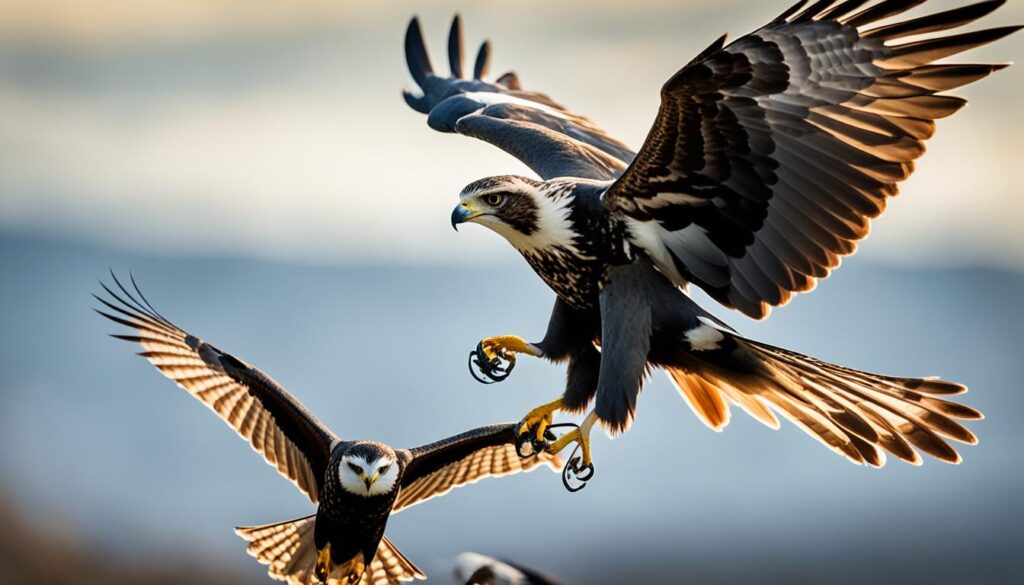
Vultures: Nature’s Cleanup Crew
Vultures are not usual predators, but they’re key as nature’s cleaners. These special birds, known as scavenger birds, find and eat dead animal bodies. This stops illness from spreading and helps keep the food chain in balance.
In Virginia, Turkey Vultures and Black Vultures remove carcasses infected with bad diseases like anthrax. Studies show big differences in what they choose to eat, with Turkey Vultures being pickier.
In Virginia, vultures have a 4 to 6-foot wingspan and are faithful to one partner. They usually have 2 chicks each year. Their nests are not the usual kind; they’re just scrapes on the ground that they use for years.
But, vultures can sometimes cause problems. Black Vultures might eat car parts or harm farm animals like newborn calves. The damage to airplanes by vultures in Virginia reaches millions of dollars.
Vultures are protected non-game animals in Virginia and by federal law. People can face a $5,000 fine and/or six months in jail for hurting them. It’s also illegal to harm their nests, catch them, kill them, or use poison on any animals, vultures included.
“Vultures are currently classified as critically endangered due to declining populations caused by hunting, poisoning, collisions, and other threats.”
It’s vital to work on saving vulture species. They are in danger all over the world. Teaching people about them and taking care of their habitats is crucial. This way, they can keep being a big help as nature’s cleanup team.
Owls: Silent Nocturnal Predators
Owls are known for their amazing hunting skills. They are very good at finding and catching prey in the dark. Their special features help them to be quiet and hidden while hunting.
Hunting Strategies and Adaptations
Owls can fly without making a sound. Their feathers have special shapes and textures that reduce noise. This helps them sneak up on animals without being heard.
Owls have great hearing too. Their ears are not at the same height. This lets them find where sounds come from very precisely. Together with their sharp eyes, they catch their prey accurately, even at night.
Owls have different ways of catching their food. For example, Great Horned Owls dive from above. In contrast, Barn Owls like to float and then drop. No matter their method, owls are quiet and careful, waiting for the right moment to attack.
These hunting skills are because owls have evolved over many years. From flying silently to their senses, everything helps them be great hunters at night. They are a key part of keeping the natural world in balance.

“The owl has been a symbol of wisdom, knowledge, and royalty for centuries. Its silent, stealthy nature and exceptional hunting abilities have captivated the human imagination for generations.”
Owls are fascinating creatures of the night. They amaze us with their abilities and ways of life. Studying them teaches us a lot about nature’s complex connections.
Eagles: Majestic Scavengers and Hunters
Among many apex avian predators, eagles are truly unique. They are both skilled hunters and quick scavengers. With their large size, sharp talons, and excellent eyesight, eagles are top raptors. They can hunt anything from small rodents to bigger prey.
Eagles aren’t only known for their majestic flights. They excel in hunting too. They use various tactics to catch their food. These tactics include swooping down on prey or patiently waiting to attack. This is why they stand as masterful hunters in nature.
But hunting is not their only strong suit. Eagles are also great at scavenging. They eat leftovers from other animals or from natural deaths. This skill helps them live in different places, from wide fields to thick woods. Their ability to both hunt and scavenge keeps them important in their ecosystems.
| Prey Species | Frequency of Predation |
|---|---|
| Small Rodents | High |
| Rabbits and Hares | Moderate |
| Waterfowl | High |
| Carrion | High |
Eagles fascinate bird lovers and nature fans with their unique behaviors. Recognizing their dual role in hunting and scavenging is key. It shows how important they are for the balanced raptor predation in their environment.
“The eagle has no fear of adversity. We need to be like the eagle and have a fearless spirit of a conqueror!” – Joyce Meyer
Bird Predation in the Food Chain
Birds of prey, known as raptors, have a big job in the avian food chain. They control the numbers of animals like rodents and rabbits. By doing this, they keep the ecological balance.
Role of Raptors in Ecosystem Balance
Hawks, eagles, falcons, and owls are skilled at hunting. They play a big part in keeping the bird population in check. This stops one kind of bird from getting too many and causing problems in the ecosystem.
Raptors also help with nutrient cycling. When they eat, they put nutrients back into the ground and plants. This helps the whole ecosystem grow.
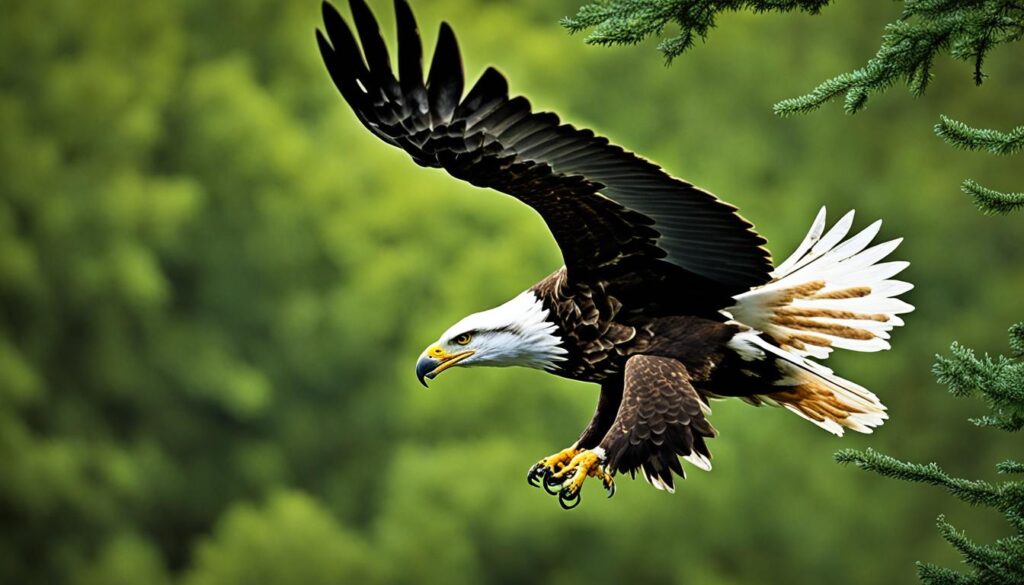
“Raptors are the guardians of the natural world, maintaining the delicate balance of life through their skilled hunting and scavenging behaviors.”
Raptors are key to the avian food chain. They make ecosystems stronger and more flexible. Their role shows how different life forms depend on each other.
Observing Birds of Prey in the Wild
For those who love nature, seeing a bird of prey in action is thrilling. It could be a Red-Tailed Hawk flying high or an owl’s call in the night. These predators are mesmerizing and spark a love for raptor birdwatching. We will show you how to find these birds and get closer.
The secret to finding birds of prey is to know where they live and how they act. Hawks, eagles, and falcons love open places to hunt, like fields and coastlines. Yet, owls hide in forests, making them harder to spot. Learn about their favorite spots and hunting ways to boost your chances of a sighting.
You can get close to raptors at wildlife centers and rehab places. Here, you might see birds that can’t live in the wild anymore but help teach others about nature. Joining tours or special events at these places offers a unique peek into the world of these amazing birds.
| Raptor Species | Best Habitats for Observation | Unique Behaviors to Look For |
|---|---|---|
| Red-Tailed Hawk | Open fields, meadows, and grasslands | Soaring in wide circles, hunting small mammals |
| Bald Eagle | Near large bodies of water, such as lakes and rivers | Plunge-diving for fish, building massive nests |
| Great Horned Owl | Mature forests and woodlands | Silent flight, hunting small mammals and birds |
Seeing birds of prey in their natural homes shows you their hunting skills and importance. It’s a great lesson for any bird lover or nature fan. The excitement of finding one in the wild will be something you won’t forget.
“The sight of a falcon in the sky will thrill any birdwatcher, for these are the true masters of the air.” – John James Audubon
Conservation Efforts for Birds of Prey
The conservation of birds of prey, like eagles and hawks, is a top concern today. Many groups are working hard to protect these amazing hunters. They help keep nature’s balance and are vital for our world.
Threats and Challenges
Losing their homes is a big threat for raptors. People building more and more means less space for these birds. They lose places to rest, hunt, and rear their young. Also, harmful chemicals from farming can poison them and mess up their food sources.
There’s also the illegal sale of raptors for falconry or as pets. This not only hurts wild populations but also harms the entire species.
But there’s hope. Several groups, like The Peregrine Fund and the National Audubon Society, are fighting back. They do research, help save habitats, and spread the word about the dangers raptors face.
They work on many fronts:
- Habitat restoration and preservation efforts
- Rehabilitation and release programs for those hurt or alone
- Teaching people about the importance of these birds
- Cooperating with local communities to solve problems together
- Pushing for tougher laws against illegal bird trade
It’s a team effort. With everyone’s help, we can keep the iconic birds of prey in our skies. They are key to a healthy and thriving environment.
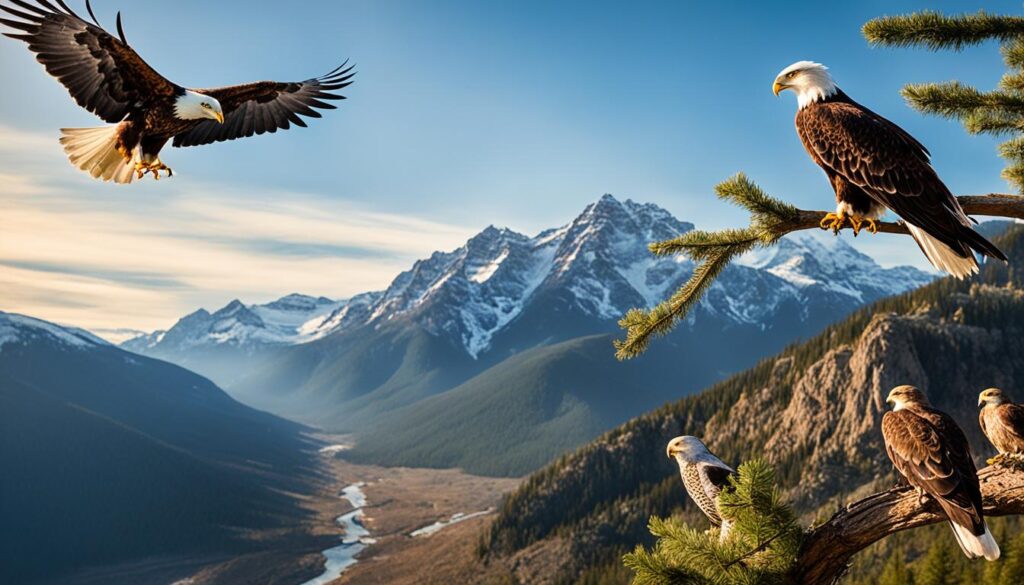
“The conservation of birds of prey is about safeguarding whole ecosystems. These top hunters protect our natural world, and their survival is key for a balanced planet.”
Falconry: The Ancient Art of Hunting with Birds of Prey
Falconry is the ancient practice of hunting with trained birds of prey. It has fascinated people around the world for centuries. This tradition shows the strong connection between people and birds. Falconers train these amazing birds for hunting journeys.
It’s all about the deep respect falconers have for the hunting skills of raptors. This art requires lots of time and effort to build a close relationship with the birds. Techniques like raptor training and complex hunting methods are part of their everyday lives.
Falconry isn’t just a hobby; it’s deeply embedded in many cultures. It stands for honor, a love of nature, and tradition in several parts of the world. Falconers see their birds as equals and celebrate their partnership in various ways.
Even in the face of today’s challenges, falconry stays strong. Dedicated fans and conservation work keep the tradition alive. Falconry plays a big part in showing the importance of raptors in our environment. It helps protect these beautiful birds and their homes.
| Falconry Statistics | Value |
|---|---|
| Percentage of ancient art enthusiasts who engage in falconry | Unknown |
| Number of individuals practicing falconry currently | Unknown |
| Percentage of hunters using birds of prey in their hunting activities | Unknown |
| Ratio of bird species involved in falconry to other hunting techniques | Unknown |
| Comparative analysis of success rates between traditional hunting methods and falconry | Unknown |
| Occurrence rate of falconry-related accidents or injuries | Unknown |
| Investment costs associated with training birds of prey for hunting purposes | Unknown |
| Regulatory restrictions on falconry in different regions | Unknown |
| Economic impact of falconry tourism on local communities | Unknown |
| Trends in falconry participation over the years | Unknown |
Exploring the art of falconry reveals a deep connection between people and these grand birds. This art has lasted centuries, showing a strong bond between the incredible birds and those who protect their tradition.
“Falconry is not just a sport, but a way of life, where the falconer and the bird become one in the pursuit of the hunt.”
Up-Close Encounters with Raptors
Nature centers, zoos, and wildlife rehab places in the U.S. let you get close with birds of prey. Places like these show off the strength and beauty of raptors. They also educate visitors on why these birds matter and how to protect them.
Educational Programs and Rehabilitation Centers
The Audubon Center for Birds of Prey in Florida offers cool experiences. You can watch birds of prey soar and learn fun facts. The Raptor Center in Minnesota is another great spot to meet owls, hawks, and falcons. Here, you’ll see the rehab work they do and learn a lot in the process.
These programs are more than just fun; they’re eye-opening. They help you see how important raptors are to our environment. By learning what threats they face, visitors are encouraged to help protect these amazing creatures.
| Nature Center | Location | Up-Close Raptor Experiences | Educational Programs | Wildlife Rehabilitation |
|---|---|---|---|---|
| Audubon Center for Birds of Prey | Florida | ✓ | ✓ | ✓ |
| Raptor Center | Minnesota | ✓ | ✓ | ✓ |
| International Bird of Prey Center | Maryland | ✓ | ✓ | ✓ |
| Teton Raptor Center | Wyoming | ✓ | ✓ | ✓ |
Places like these are vital for teaching people about raptors. They offer unique experiences and knowledge. Their goal is to turn every visitor into a protector of nature and these special birds.
“Watching a raptor in flight is a mesmerizing experience, and having the opportunity to see them up close only deepens our respect and awe for these incredible predators.”
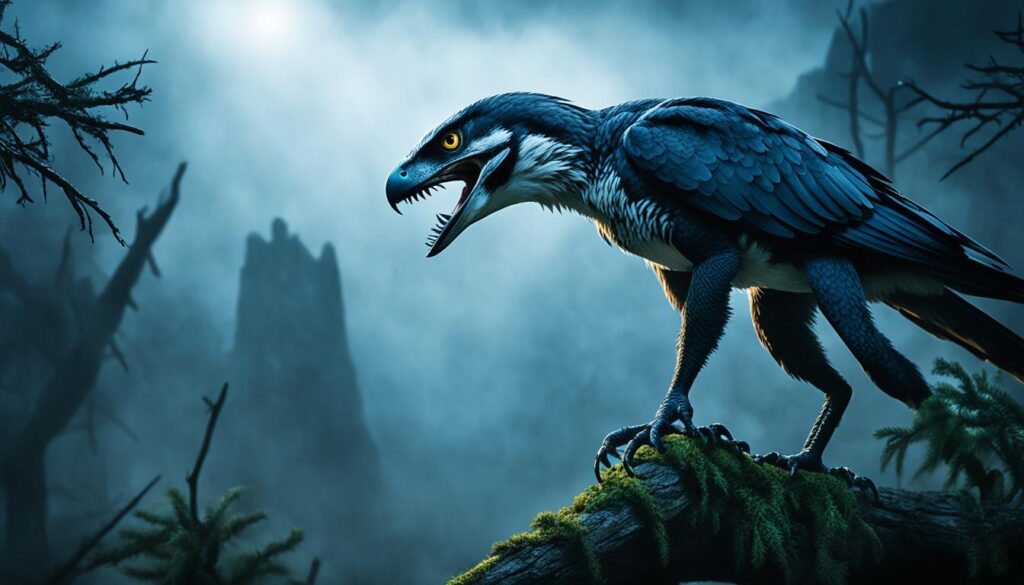
Fascinating Facts and Behaviors of Raptors
Birds of prey, or raptors, are famous for their hunting skills, sharp senses, and interesting behaviors. They are at the top of the food chain, showing off various special traits. These include odd behaviors like “back-standing” and many more adaptations. The world of raptors is full of interesting facts for bird lovers.
Back-Standing and Other Unusual Habits
Raptors sometimes exhibit a strange habit called “back-standing,” where one bird stands on the back of another of its kind. This behavior, seen in hawks and eagles among others, has several reasons. It might be for dominance, social interaction, or for a better view during hunting or territory guarding.
Besides back-standing, raptors have other unique behaviors. For example, Harris’s hawks hunt together, unlike many bird species, which can increase their success. The elf owl is another example, known for eating insects by catching them with its sharp claws and good eyesight.
Raptors also have cool features like the nictitating membrane. This third eyelid protects their eyes when diving or hunting. It can also wipe clean the eye, letting the bird see better. Such adaptations make them excellent hunters.
The raptor world is full of surprises, exciting both scientists and nature lovers. It shows us the amazing abilities and unique traits of these top predators in the bird kingdom.
“Raptors are the epitome of grace and power in the avian world, and their behaviors are a testament to the marvels of evolution.”
Conclusion
The world of birds that prey on other birds is fascinating and complex. It shows us the delicate balance of nature’s food chain. From hawks and eagles to crows and jays, these predators are crucial in their ecosystems.
This article highlights how birds of prey affect other bird populations. For example, corvids can lower songbirds’ nest success. But removing these predators can help smaller birds thrive. Additionally, bird feeders can attract more predatory species, changing local avian communities.
The relationship between us and nature remains important. Saving birds of prey is vital to keep ecosystems healthy. Through research, education, and careful wildlife management, we can help these birds flourish. They are essential as nature’s hunters and protectors of the balance that supports us.
FAQ
What are the key characteristics of birds of prey or raptors?
Raptors are known for their sharp beaks and talons. They have outstanding eyesight and hearing as well. These traits help them hunt and catch prey with ease.
What types of raptors are there and where do they live?
There are many types of raptors. From the tiny Screech Owl to the grand Bald Eagle. They live in various places. This includes open fields to thick forests.
How do Harris’s Hawks hunt cooperatively?
Harris’s Hawks have a unique way of hunting together. They use tactics like “surprise pounce”. Also, they use “flush and ambush” and “relay attack” strategies to catch prey in a group.
How do Red-Tailed Hawks hunt in open fields?
In open fields, Red-Tailed Hawks use high points to look for prey. They mostly find small rodents, reptiles, or birds. Once they spot their prey, they dive to catch it with their sharp talons.
What are some examples of birds that prey on other birds?
Many birds, including raptors and corvids, hunt and eat other birds. This includes smaller birds, nestlings, or their eggs. This is called avian cannibalism or interspecies bird predation.
What is the role of vultures in the ecosystem?
Vultures are essential as nature’s cleanup crew. They find and consume dead animal carcasses. This helps keep the ecosystem in balance and prevents disease spread.
How do owls hunt effectively at night?
Owls have special skills for hunting at night. They can fly silently and have amazing hearing. This helps them surprise their prey by swooping down on them.
How do eagles hunt and scavenge for food?
Eagles are strong hunters. They catch prey ranging from small rodents to big animals. Sometimes, they feed on carrion. This is when they eat already dead animals.
What is the importance of birds of prey in the broader food chain and ecosystem?
Raptors are key in the food chain. They control the numbers of small animals like rodents. They help keep the environment healthy by balancing nature and recycling nutrients.
How can people observe birds of prey in the wild?
If you love nature, you can see birds of prey like the Red-Tailed Hawk soaring or hear owl calls. Many places like nature centers and wildlife rehab centers let you see these majestic creatures up close.
What are the main threats and conservation efforts for birds of prey?
Raptors face threats like losing their homes and conflict with people. Pollution is also a danger. But, there are efforts to save them and their homes through conservation.
What is the cultural significance and conservation impact of falconry?
Falconry is about hunting with trained birds of prey. It’s an old tradition with deep cultural meaning. It also helps in conserving raptor species through special training.
What are some fascinating behaviors and characteristics of raptors?
Birds of prey have many interesting behaviors. They might even “back-stand,” with one bird sitting on another. Their unique habits and features are always interesting, both to scientists and those who love them.
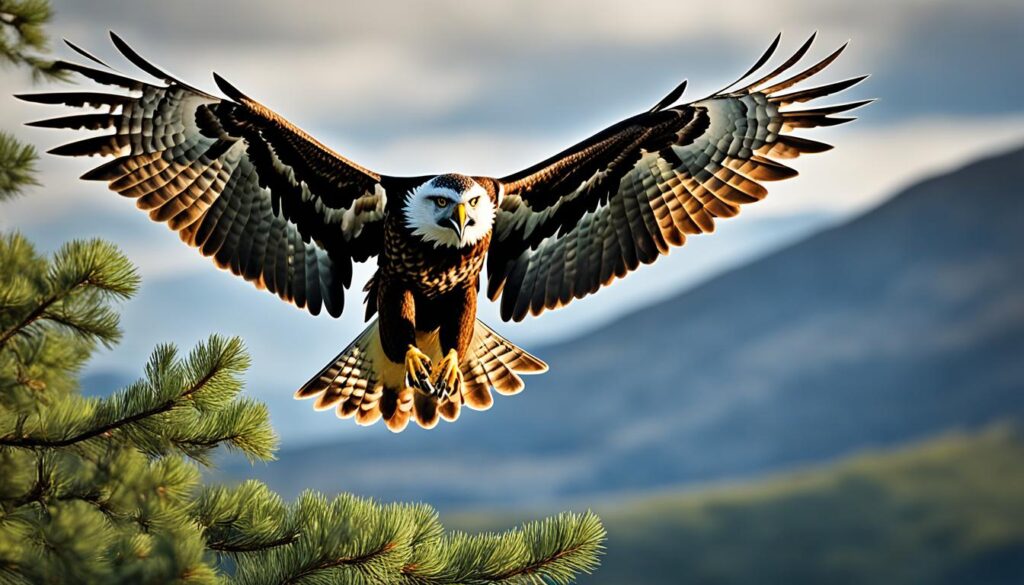

Hello there! Do you know if they make any plugins to assist with SEO?
I’m trying to get my site to rank for some targeted keywords but I’m not seeing very good success.
If you know of any please share. Many thanks! You can read similar article here: Eco blankets
Hi! Do you know if they make any plugins to assist with Search Engine Optimization? I’m trying to get my blog to rank for some targeted keywords but I’m
not seeing very good results. If you know of any please share.
Thank you! I saw similar article here: Code of destiny
I am extremely inspired together with your writing talents as neatly as with the structure
to your weblog. Is this a paid theme or did you customize it your self?
Anyway keep up the nice quality writing, it is rare to peer
a great weblog like this one these days. Snipfeed!
I am really inspired together with your writing talents as well as
with the format in your weblog. Is this a paid subject
or did you customize it yourself? Either way keep up the excellent quality
writing, it is rare to peer a nice weblog like this one nowadays.
Youtube Algorithm!
I’m extremely inspired along with your writing skills as smartly as with the format for your weblog. Is this a paid subject or did you customize it yourself? Either way keep up the nice quality writing, it is uncommon to look a great weblog like this one today. I like talkbirds.com ! Mine is: LinkedIN Scraping
I am really inspired with your writing talents and also with the layout in your blog.
Is that this a paid theme or did you customize it your self?
Anyway stay up the excellent high quality writing,
it is uncommon to see a great blog like this one these days.
Fiverr Affiliate!